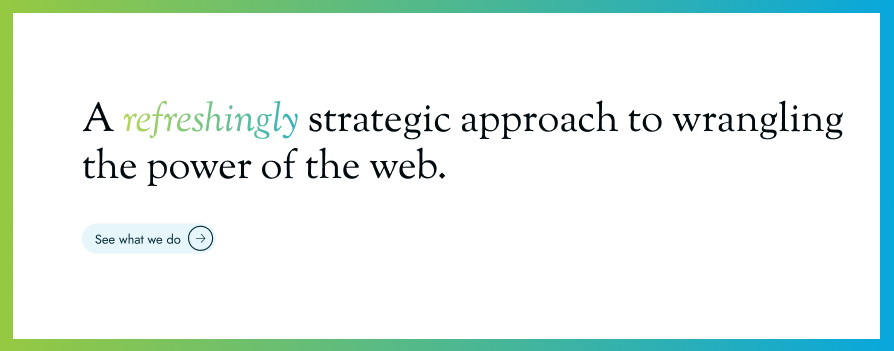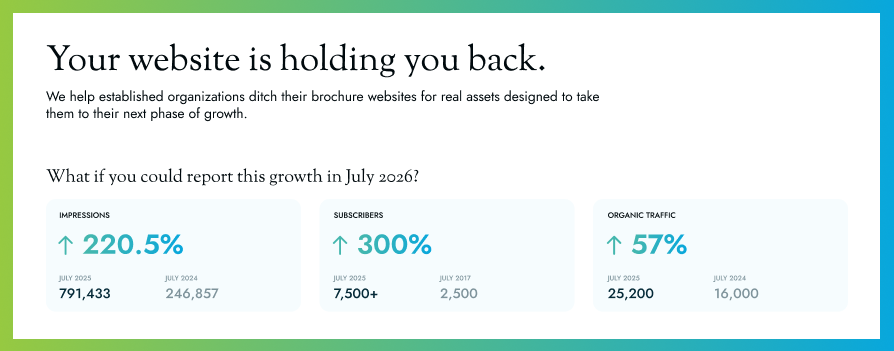When we relaunched our new site this year, we took it as an opportunity to play around with some fun new things under the hood. Going with a headless WordPress approach, utilizing Astro.js, and combining content from multiple sources (2 WordPress installs as well as local json data). We wanted to "dog food" some things that we were working on and investigating for our clients.
In that process, we also updated our content to more accurately reflect what we actually do today. Most of that is internal definition that is helpful for potential clients to see, but it doesn't really let a potential client see themselves in our solutions. We weren't specific enough about who we help and how so it is difficult for them to see us as a solution to the issues they're currently facing.
There's content and then there's positioning
I recently read a LinkedIn post (apparently it's not all just AI bots and spam these days) that suggested that if your positioning statement as a company can be copied and pasted onto any other site in your industry, it is not a positioning statement.
A positioning statement clearly defines what makes you different. It helps your target audience see who you are and what you offer as a specific solution to their problems.
Good "positioning" should be a little scary
Good positioning picks an audience and commits. This can give a lot of clarity to the rest of your content, your strategy, and how you engage online and on social media.
However, good positioning will almost certainly alienate some potential clients. There will be some that come to your site and aren't able to clearly see themselves fitting, although your services might be a great fit for them. The expectation though, is that you'll get greater conversion with the more precise fits than you lose.
What is LimeCuda's positioning?
This is something we've struggled to answer for years. We work to help our clients convert their positioning into an effective web strategy every day. But... the cobbler's kids...
For a while, we leaned into what we wanted to do. It wasn't a specific type of work or specific type of client. We defined it as "we want to do good work for good people". This vague approach did work for us for a while. It gave us a guiding principle for how we approached picking new projects and relationships that we pursued. Some of the relationships we established with this philosophy have continued to be wonderful clients to this day.
These relationships have also generated some great referrals over the years that we're truly grateful for. However, a referral based business is not a strategy.
"Refreshingly strategic approach to wrangling the power of the web"

When we relaunched, we used the same positioning that we had for years, "Refreshingly strategic approach to wrangling the power of the web". It is a slight modification of a version that I thought had a really clever connection to our name, "Refreshingly aggressive approach..." ("Lime" -> "Refreshingly", "Cuda" -> "Aggressive").
However, almost any web development company could throw that up as their headline and it would work to define them (minus the cute connection to our name).
What have we changed?

We've been having great success with established organizations whose websites haven't kept pace with their real-world growth. These companies were often around before the internet, so while they have solid industry reputations, presence at conferences, and loyal customers, their websites are grossly outdated.
But, more than being outdated, their websites have become an anchor for them. The website is actually holding them back. There is no real strategy, no structure to easily share their value or for customers to engage with the many resources they already have. Very little for search engines (and now AI systems) to assess who they are and return them for searches they should be the number one result for (and now have become with our help!).
So, we just updated our positioning to better match this type of client. Is it perfect? Nope! Is it super clear on our target audience and how we can specifically help them? Not really. It will be a continuing work in progress, but we do think it is a step in the right direction and includes some visuals to help convey context that we hope reenforce the specifics of what we can bring to those organizations.
Let us know what you think!
